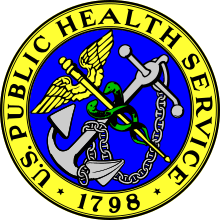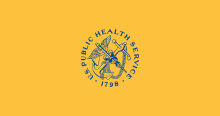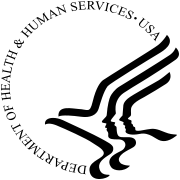United States Public Health Service
The United States Public Health Service (USPHS) is a division of the Department of Health and Human Services concerned with public health. It contains eight out of the department's eleven operating divisions. The Assistant Secretary for Health (ASH) oversees the PHS. The Public Health Service Commissioned Corps (PHSCC) is the federal uniformed service of the USPHS, and is one of the eight uniformed services of the United States.
 Logo of the United States Public Health Service | |
 Flag of the U.S. Public Health Service | |
| Agency overview | |
|---|---|
| Formed | 1798 (reorganized/renamed: 1871/1889/1902/1912) |
| Jurisdiction | Federal government of the United States |
| Headquarters | Hubert H. Humphrey Building Washington, D.C. |
| Agency executive | |
| Parent agency | Department of Health and Human Services |
| Website | www.hhs.gov/ash |
| "Public Health Service March"[1] | |
Its origins can be traced to the establishment in 1798 of a system of marine hospitals. In 1870 these were consolidated into the Marine Hospital Service, and the position of Surgeon General was established. In 1889, the PHSCC was established. As the system's scope grew, it was renamed the Public Health Service in 1912. The Public Health Service Act of 1944 consolidated and revised previous laws and is the current legal basis for the PHS. It became part of the Federal Security Agency and later the Department of Health, Education and Welfare, which became the Department of Health and Human Services on May 4, 1980.
Organization
As part of the Public Health Service, eight from eleven divisions with the Department of Health and Human Services are listed:[2]
- National Institutes of Health
- Centers for Disease Control and Prevention
- Indian Health Service
- Food and Drug Administration
- Agency for Toxic Substances and Disease Registry
- Health Resources and Services Administration
- Agency for Healthcare Research and Quality
- Substance Abuse and Mental Health Services Administration
The three other divisions are designated human services agencies and are not part of the Public Health Service. These are the Centers for Medicare and Medicaid Services, Administration for Children and Families, and Administration for Community Living.[2][3]
The Assistant Secretary for Health is the senior official in charge of the Public Health Service. The Office of the Assistant Secretary for Health contains the following core agencies:[4]
- National Vaccine Program Office (NVPO)
- Office of Adolescent Health (OAH)
- Office of Disease Prevention and Health Promotion (ODPHP)
- Office of HIV/AIDS and Infectious Disease Policy (OHAIDP)
- Office for Human Research Protections (OHRP)
- Office of Minority Health (OMH)
- Office of Population Affairs (OPA)
- Office of Research Integrity (ORI)
- Office of the Surgeon General (OSG)
- Public Health Service Commissioned Corps
- Office on Women's Health (OWH)
- President's Council on Sports, Fitness, and Nutrition (PCSFN)
United States Public Health Service Commissioned Corps
The United States Public Health Service Commissioned Corps (PHSCC) employs more than 6,000 uniformed public health professionals for the purpose of delivering public health promotion and disease prevention programs and advancing public health science. Members of the Commissioned Corps often serve on the frontlines in the fight against disease and poor health conditions.
The mission of the U.S. Public Health Service Commissioned Corps is to protect, promote, and advance the health and safety of the people of the United States. According to the PHSCC, this mission is achieved through rapid and effective response to public health needs, leadership and excellence in public health practices, and advancement of public health science.
As one of the United States eight uniformed services, the PHS Commissioned Corps fills public health leadership and service roles within federal government agencies and programs. The PHS Commissioned Corps includes officers drawn from many professions, including environmental and occupational health, medicine, nursing, dentistry, pharmacy, psychology, social work, hospital administration, health record administration, nutrition, engineering, science, veterinary, health information technology, and other health-related occupations.
Officers of the Corps wear uniforms similar to those of the United States Navy with special PHSCC insignia, and the Corps uses the same commissioned officer ranks as the U.S. Navy, the U.S. Coast Guard, and the NOAA Commissioned Officer Corps from ensign to admiral, uniformed services pay grades O-1 through O-10 respectively.
According to 5 U.S.C. § 8331, service in the PHSCC after June 30, 1960 is considered military service for retirement purposes. Under 42 U.S.C. § 213, active service in the PHSCC is considered active military service for the purposes of most veterans' benefits and for antidiscrimination laws.[5]
History
Marine Hospital Service
The origins of the Public Health Service can be traced to the passage, by the 5th Congress of the United States, of "An Act for the Relief of Sick and Disabled Seamen" in July of 1798.[6] This act created Marine Hospitals to care for sick seamen. They were initially located along the East Coast, at the harbors of the major port cities. As the boundaries of the United States expanded, and harbors were built on other coasts, so too were marine hospitals.[7] The Marine Hospital Service was placed under the Revenue Marine Service (a forerunner of the present-day Coast Guard) within the Department of the Treasury.[8]
A reorganization in 1870 converted the loose network of locally controlled marine hospitals into a centrally controlled Marine Hospital Service, with its headquarters in Washington, D.C. This reorganization made the Marine Hospital Service into its own bureau within the Department of the Treasury.[8] The position of Supervising Surgeon (later titled the Surgeon General) was created to administer the Service, and John Maynard Woodworth, (1837-1879), was appointed as the first incumbent in 1871.[9] He moved quickly to reform the system and adopted a military model for his medical staff; putting his physicians in uniforms, and instituting examinations for applicants. Woodworth created a cadre of mobile, career service physicians, who could be assigned as needed to the various Marine Hospitals. The commissioned officer corps was established by legislation in 1889, and signed by 22nd/24th President Grover Cleveland.
The scope of activities of the Marine Hospital Service also began to expand well beyond the care of merchant seamen in the closing decades of the nineteenth century, beginning with the control of infectious disease. The National Quarantine Act of 1878 vested quarantine authority to the Marine Hospital Service. and the National Board of Health.[10] The Marine Hospital Service was assigned the responsibility for the medical inspection of arriving immigrants at sites such as Ellis Island in New York Harbor. Because of the broadening responsibilities of the Service, its name was changed in 1902 to the "Public Health and Marine Hospital Service". As the emphasis of its responsibilities shifted from sailors to general public health and with the decommissioning of various old marine hospitals the name was changed again, in 1912, to just the "Public Health Service" (PHS).
Consolidation and expansion
In 1939, the Public Health Service was transferred from the Department of the Treasury into the new Federal Security Agency.[11] At that time the National Institute of Health [sic] was already established as a division of the PHS.[8] In 1942 the Communicable Disease Center, which would become the Centers for Disease Control and Prevention, was established within the PHS.[12] All of the laws affecting the functions of the public health agencies were consolidated for the first time in the Public Health Service Act of 1944.[8]
In 1953 the Federal Security Agency was abolished and most of its functions, including the PHS, were transferred to the newly formed Department of Health, Education and Welfare. In 1955 the Indian Health Service was established upon transfer of these functions from the Bureau of Indian Affairs.[13]
In 1968, the position of Assistant Secretary for Health was created, supplanting the Surgeon General as the top leader of the Public Health Service, although the Surgeon General was retained in a subordinate role.[14] Also in 1968, the Food and Drug Administration, which traces its origins to 1862, became part of the PHS.[15]
On May 4, 1980, the Department of Health, Education and Welfare was renamed as the Department of Health and Human Services.[16] The other four agencies of the PHS were formed between 1980 and 1992.
In 1995, supervision of the agencies within the Public Health service was shifted from the Assistant Secretary for Health to the Secretary of Health and Human Services.[14]
Activities
In the area of environmental protection and public health, a Public Health Service 1969 community water survey that looked at more than a thousand drinking water systems across the United States drew two important conclusions that supported a growing demand for stronger protections that were adopted in the 1974 Safe Drinking Water Act. The survey concluded, first, that the state supervision programs were very uneven and often lax, and, second, that the bacteriological quality of the water, particularly among small systems, was of concern.[17]
The 1963 Clean Air Act gave the Public Health Service in the Department of Health, Education, and Welfare the authority to take abatement action against industries if it could be demonstrated that they were polluting across state lines, or if a governor requested. Some of these actions involved the Ohio River Valley, New York, and New Jersey. The service also began monitoring air pollution. the 1967 Clean Air Act redirected attention to larger air quality control regions.[18]
Controversies
Tuskegee Study of Untreated Syphilis in the Negro Male
In 1932, the Public Health Service, working with the Tuskegee Institute in Tuskegee, Alabama, began a study to record the natural history of syphilis in hopes of justifying treatment programs for blacks. It was titled the Tuskegee Study of Untreated Syphilis in the Negro Male.
The study initially involved 600 black men—399 with syphilis, 201 who did not have the disease. The study was conducted without the benefit of patients' informed consent. Researchers told the men they were being treated for "bad blood," a local term referring to several ailments, including syphilis, anemia, and fatigue. In truth, they did not receive the proper treatment needed to cure their illness. In exchange for taking part in the study, the men received free medical exams, free meals, and burial insurance. Although originally projected to last 6 months, the study actually went on for 40 years. Penicillin - which can be used to treat syphilis—was discovered in the 1940s. However, the study continued and treatment was never given to the subjects. Because of this, it has been called "arguably the most 'infamous' biomedical research study in U.S. history".[19]
Syphilis studies in Guatemala
A USPHS physician who took part in the 1932–1972 Tuskegee program, John Charles Cutler, was in charge of the U.S. government's syphilis experiments in Guatemala, in which in the Central American Republic of Guatemala, Guatemalan prisoners, soldiers, orphaned children, and others were deliberately infected with syphilis and other sexually-transmitted diseases from 1946 to 1948, in order to scientifically study the disease, in a project funded by a grant from the National Institutes of Health of the United States in Bethesda, Maryland.
Secretary of State Hillary Clinton apologized to the Republic of Guatemala for this program in 2010, in light of the serious ethical lapses in moral judgement which occurred.[20]
See also
- Cadet Nurse Corps
- Human experimentation in the United States
- Lucy Minnigerode, first superintendent of the U. S. Public Health Service Nursing Corps
- Narcotic Farms Act of 1929
- Public Health Service Act
- Title 42 appointment
References
This article is based on the public domain text History of the Commissioned Corps, PHS
- other(s), Jarminator CMS 3.0 created by Dwayne Jarman, DVM, MPH - page ontent created by. "Ensemble". dcp.psc.gov. Retrieved 26 February 2018.
- Redhead, C. Stephen; Dabrowska, Agata (2015-10-13). "Public Health Service Agencies: Overview and Funding (FY2010–FY2016)" (PDF). U.S. Congressional Research Service. Retrieved 2018-10-16.
- "HHS Organization Chart". U.S. Department of Health and Human Services. 2008-10-24. Retrieved 2018-10-17.
- "Public Health Offices". U.S. Department of Health and Human Services. 2016-03-21. Retrieved 2018-10-17.
- "Title 42 - The Public Health and Welfare" (PDF). US Government Printing Office.
- Ungar, Rich (17 January 2011). "Congress Passes Socialized Medicine and Mandates Health Insurance - In 1798". Forbes. Retrieved 25 February 2020.
- Gostin, Lawrence O. (2008). "Box 8: The Federal Presence in Public Health". Public Health Law: Power, Duty, Restraint, Revised and Expanded (2nd ed.). University of California Press. p. 156. ISBN 0520253760. Retrieved 2012-11-08.
- "Images From the History of the Public Health Service: Introduction". nlm.nih.gov. Retrieved 2017-12-03.
- Christopher, Dean (5 October 2007). "20 Things You Didn't Know About... The Surgeon General". Discover. Retrieved 25 February 2020.
- Smillie, W. G. "The National Board of Health, 1879-1883" American Journal of Public Health and The Nation's Health (1943) 33(8):925-930.
- "Message to Congress on the Reorganization Act". The American Presidency Project. 1939-04-25. Retrieved 2018-10-23.
- "Our History - Our Story | About | CDC". cdc.gov. 2018-07-20. Retrieved 2018-10-23.
- ""If You Knew the Conditions..." Health Care to Native Americans: Indian Health Service Today". nlm.nih.gov. Retrieved 2018-10-23.
- Landman, Keren (2019-06-24). "For America's Public Health Officers, Questions of Duty and Purpose". Undark Magazine. Retrieved 2020-07-11.
- Commissioner, Office of the. "FDA's Evolving Regulatory Powers - FDA's Origin". fda.gov. Retrieved 2018-10-23.
- "HHS Historical Highlights". United States Department of Health and Human Services. Retrieved 25 February 2020.
- EPA Alumni Association: Senior EPA officials discuss early implementation of the Safe Drinking Water Act of 1974, Video, Transcript (see p4).
- “Early Implementation of the Clean Air Act of 1970 in California.” EPA Alumni Association. Video, Transcript (see p1). July 12, 2016.
- Katz RV, Kegeles SS, Kressin NR, et al. (November 2006). "The Tuskegee Legacy Project: willingness of minorities to participate in biomedical research". J Health Care Poor Underserved. 17 (4): 698–715. doi:10.1353/hpu.2006.0126. PMC 1780164. PMID 17242525.
- McNeil, Donald G., Jr. (2010-10-01). "Syphilis Experiment Is Revealed, Prompting U.S. Apology to Guatemala". The New York Times.
Further reading
- Blue, Rupert (September 1917). "Conserving The Nation's Man Power: How The Government Is Sanitating The Civil Zones Around Cantonment Areas. A Nationwide Campaign For Health". National Geographic Magazine. XXXII (3): 255–278.
- Hendrick, Burton J. (April 1916). "The Mastery of Pellagra: How the Doctors of the United States Public Health Service Have Found a Way of Curing and Preventing It". The World's Work: A History of Our Time. XXXI: 633–639. Retrieved 2009-08-04.
- Leupp, Constance D. (August 1914). "Removing The Blinding Curse of the Mountains: How Dr. McMullen, of the Public Health Service Is Organizing ahe War against Trachoma in the Appalachians". "The World's Work: A History of Our Time". XLIV (2): 426–430. Retrieved 2009-08-04.
- Annual Report of the Surgeon General of the Public Health. Washington, D.C.: Government Printing Office.
External links
| Wikimedia Commons has media related to United States Public Health Service. |
- Office of the Assistant Secretary for Health
- Public Health Service in the Federal Register
- Office of the Surgeon General
- Office of the Public Health Service Historian (part of the National Institutes for Health
- PHS history and WWII women's uniforms in color – World War II US women's service organizations (WAC, WAVES, ANC, NNC, USMCWR, PHS, SPARS, ARC and WASP)
- The V.D. Radio Project at The WNYC Archives
- Works by United States Public Health Service at Project Gutenberg
- Works by or about United States Public Health Service at Internet Archive
![]()
